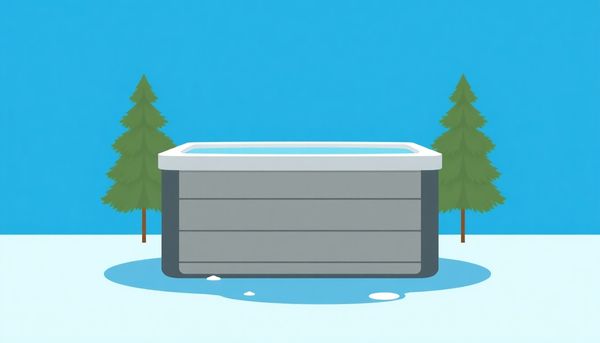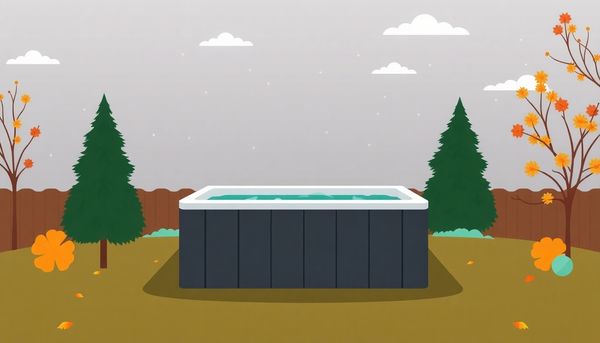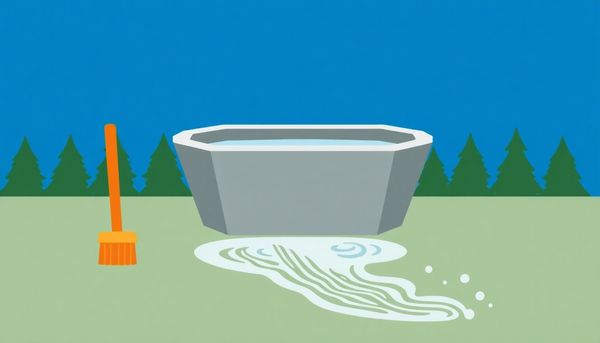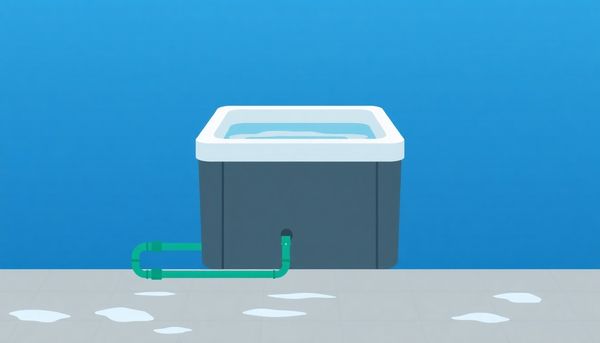Essential Hot Tub Winterization Tips to Avoid Costly Repairs
January 28th, 2024
January 28th, 2024
As the crisp autumn air sets in and the leaves turn to shades of amber, the anticipation of winter's chill begins to stir. For hot tub owners, this seasonal transition is a gentle reminder that it's time to prepare for the colder months ahead. I recall a chilly November evening a few years back when I neglected to winterize my hot tub properly. The result was a cracked pipe and an unwelcome repair bill, a lesson learned the hard way. Avoiding such pitfalls requires a thoughtful approach, ensuring your beloved spa remains in pristine condition through snow and frost.
Winterizing a hot tub isn't just about averting mechanical mishaps; it's about maintaining the sanctuary you’ve come to cherish. Each component, from the delicate jets to the robust heater, deserves attention and care. By integrating a few targeted strategies, you can protect your investment and ensure it's ready to offer warmth and relaxation as soon as spring makes its return. Techniques vary, but the essence of winterization lies in understanding the intricacies of your specific model and climate.
In this guide, we'll explore the steps necessary to shield your hot tub from winter's harsh embrace. By following these insights, you'll transform what might seem like a daunting task into a straightforward ritual, ensuring your spa remains your personal oasis year-round. Let’s embark on this journey to safeguard your hot tub, transforming maintenance into a seamless part of your seasonal rhythm.

Closing your hot tub for winter isn't just about sealing it up and saying goodbye until spring. There’s a meticulous process that ensures your cherished spa survives the frosty months unscathed. Whether it’s your first attempt or you’re a seasoned pro, the steps remain crucial.
Begin with the basics: halting all chemical additions. This allows chlorine and bromine levels to dissipate naturally, preventing any chemical residue from damaging the tub components while it sits dormant. Once the water reaches safe levels, cut off the power supply entirely. This step isn’t just about saving energy—it also prevents any accidental activation during maintenance.
Next comes the draining. Using a garden hose attached to your drain spout is the traditional method, but a sump pump can expedite the process. Just be sure not to let the pump run dry to avoid damage. Once the tub is mostly empty, focus on clearing out the remaining water, especially from the plumbing. A shop vac set to blow mode can be your best friend here, ensuring every last drop is expelled from the pipes and jets.
Cleaning the tub shell and removing filter cartridges are next on the list. A thorough clean with a mild, non-abrasive cleaner will keep the shell in perfect condition. Filters should be either deeply cleaned or replaced, so they’re ready for action come spring.
Finally, don’t neglect the cover. Clean and dry it thoroughly to prevent mold growth, and secure it tightly against winter winds using locks and wind straps. By taking these steps, your hot tub will be ready to welcome you with bubbling warmth when the thaw returns.
Before the first frost nips at your doorstep, it's crucial to ensure your hot tub is properly prepared for its winter hibernation. Draining and removing water is more than just pulling a plug and waving goodbye till spring. Once you’ve disconnected the power—because safety is non-negotiable—your next task is to address the water sitting snug inside the tub. Attach a garden hose to the drain spout; this ensures a steady flow of water to the desired drainage area, preventing backyard flooding. Remember, letting several hundred gallons loose requires a bit more planning than emptying a kiddie pool.
For those short on time or patience, a sump pump is your ally. It can be a real game-changer, swiftly siphoning out the majority of water. Still, a few stubborn inches may cling to the shell. This is where a trusty shop-vac can step in for the final sweep. Don’t toss aside those last puddles of water; they might just freeze and expand, causing unwelcome cracks.
Once the tub is empty, the task isn't over. Delve into the inner workings of your spa by loosening PVC pipe unions and removing any drain plugs from the pump. This step ensures that hidden water doesn’t linger in the shadows of your plumbing, waiting to wreak havoc. With the bulk of the water banished and your hot tub standing empty, you’ve taken a significant stride in safeguarding your spa for the winter months.
As winter approaches, the task of preparing your hot tub for the colder months becomes essential. One often overlooked aspect is the importance of cleaning and protecting your hot tub's surfaces. Think of this as giving your spa a well-deserved spa day, ensuring it stays in pristine condition until spring.
First, start with the tub's interior. Using a non-abrasive sponge and a specialized hot tub surface cleaner, gently scrub the interior shell. Opt for a cleaner that doesn't require rinsing, like diluted white vinegar, to effectively tackle those pesky waterline marks and any hot tub scum that might have accumulated. Pay special attention to the nooks and crannies, as dirt loves to hide in those little corners. Consider removing the headrests to clean any hidden spots beneath them; you’d be surprised how much can gather there over time.
Next, focus on the hot tub cover. An often neglected part, it needs careful cleaning too. A cleaner that doubles as a protectant is ideal, especially for outdoor covers. Thoroughly clean the top, sides, and undersides, ensuring no residue is left behind. Let it air dry completely to avoid trapping moisture that could lead to mold. Secure the cover with wind straps to prevent any unwanted surprises during a winter storm.
Taking these steps not only protects your investment but ensures returning to a sparkling clean hot tub when the warmer weather arrives. By dedicating just a bit of time now, you’re setting the stage for many more relaxing soaks in the future.
Facing winter's embrace, a hot tub's cover becomes its guardian against the elements. The importance of securing your spa beneath a sturdy, well-maintained cover cannot be overstated. Neglecting this step can transform your hot tub into a casualty of cold weather woes, leading to costly repairs or replacements.
Begin with a thorough cleaning of the cover, using a specialized cleaner that doubles as a protectant. This ensures that the cover can withstand harsh UV rays and prevents deterioration from the elements. Pay attention to every seam and stitch, as these can be potential weak points where water likes to sneak in.
With the cover spotless, ensure it's completely dry before setting it in place. Moisture trapped beneath can breed mold and mildew, which are unwelcome guests during the colder months. Once dry, secure it firmly over the spa. If your cover is equipped with locks, engage them to keep unwanted visitors at bay, be they curious critters or the neighborhood kids.
However, even locked covers can become airborne in a strong gust. Adding wind straps offers an extra layer of security, anchoring the cover tightly despite tempestuous weather. This preventative measure ensures that your hot tub remains shielded, avoiding the catastrophic freeze that could damage its delicate components.
In this vigilant effort, you're not just covering your hot tub; you’re safeguarding your investment for many seasons to come.

Draining and cleaning a hot tub for winter storage isn't just a chore—it's a crucial step to ensure your bubbly oasis remains in top shape come spring. First things first, you’ll need to power down your hot tub completely. Unplug it or switch off the breaker to ensure no electricity is flowing. This is essential for safety—no one wants a shocking surprise in the middle of a winterization process.
Next, attach a garden hose to the drain spout to direct water to the appropriate drainage area. If you're short on time, a sump pump can expedite this process. Remember, a couple of inches of water might still linger at the bottom; fear not, it’s easily tackled later.
Once most of the water is out, switch gears to a wet-dry vac. This handy tool helps blow out any remaining water from the plumbing lines, jets, and filter cavity. Embrace this moment as your chance to ensure every drop is expelled, which is crucial to prevent pipe damage from freezing.
With the water out, turn your attention to cleaning. A non-abrasive sponge paired with a dedicated hot tub cleaner will help you scrub away any residue, focusing on those tricky waterline rings. Don’t overlook the headrests—water often sneaks under them.
Finally, tackle the cover with a good cleaner and protectant, ensuring it’s bone dry before closing. Consider securing it with wind straps for added protection, guarding against winter's blustery challenges. With these steps, your hot tub will hibernate safely, awaiting its spring awakening.
Safety isn't just a recommendation when it comes to winterizing your hot tub—it's a must-do step. Turning off the power supply is the crucial first move to ensure everything runs smoothly without any shocking surprises. Before you start any draining or cleaning processes, locate your hot tub’s breaker and switch it off completely. Some hot tubs allow you the luxury of simply unplugging them, which simplifies things. But be thorough: double-check that no power is flowing to any part of your tub. This precaution protects not only you but anyone else joining in on the task.
In a personal anecdote, a friend once overlooked this vital step and ended up with a ruined control panel after water accidentally splashed onto live parts. Such mishaps can lead to costly repairs and dangerous situations. Trust me, spending those few extra minutes securing the breaker or cord is worth avoiding both heartache and headache.
With the power safely off, you're free to proceed with draining and cleaning. This is when the real work begins, but remember, you've already tackled the most significant safety measure. By ensuring no electricity mingles with water, you've set the stage for a smooth winterizing process. And ultimately, you'll sleep easier knowing your spa is safe from the potential hazards of icy weather.
Winterizing a hot tub involves more than just turning off the power and slapping on a cover. One of the crucial steps in this process is ensuring that every drop of water is removed, particularly from the plumbing. Even a small amount of leftover water can freeze, expand, and cause serious damage to your hot tub's pipes and equipment.
Begin by thoroughly draining the hot tub itself. After you've let the water levels fall, it’s time to tackle the hidden areas where water can stubbornly linger. This is where your shop vacuum becomes your best friend. Switch it to the blow setting and direct its nozzle into every valve, drain, and jet. It’s an effective way to force out any water that might still be clinging to the insides of the pipes. Don’t forget the filter cavity; blowing through there can often expel residual water you might overlook.
Once you've finished with the blowing process, inspect the tub for any remaining water. Use a soft cloth or sponge to absorb any puddles, focusing on the nooks and crannies, particularly beneath headrests and around the edges. This attention to detail ensures that your hot tub is entirely free of water, reducing the risk of winter-related damage. It’s a bit like giving your hot tub a thorough spring cleaning—except this time, you’re preparing it to withstand the coldest months of the year.
When the crisp bite of winter nips at your fingertips, ensuring your hot tub is clean and shielded becomes paramount. A neglected surface can harbor mildew, which not only looks unpleasant but may also damage the lining over time. So, with your hot tub drained and dry, it’s time to nurture its surfaces back to life.
Start by gently wiping down the tub's shell with a non-abrasive sponge. A trusted companion in this endeavor is a mild hot tub surface cleaner or a homemade solution of vinegar and water. Reaching into every crevice can be surprisingly therapeutic and oddly satisfying, like finding forgotten treasures in an attic. Be sure to tackle any stubborn rings or calcium deposits—letting the cleaner sit can make the scrubbing easier.
Remember the headrests. Often overlooked, these areas can trap moisture and grime. Removing them allows you to clean beneath, ensuring no hidden corners are left vulnerable. Once the interior is spotless, turn your attention to the cover. A thorough cleaning here is equally important, not just for aesthetics but to prevent mold growth. A quality cover cleaner with UV protection will keep it safe from harsh winter sunlight, extending its life.
Before sealing up for the season, ensure everything is completely dry. Moisture left behind is an open invitation for mold and mildew, an unwelcome surprise when spring arrives. With meticulous attention to these details, your hot tub will be ready to welcome you back when the frost thaws.

In the heart of winter, the last thing you want is to discover cracked or burst pipes in your dormant hot tub. Ensuring your spa’s plumbing remains intact through the cold months is not just about draining the tub; it’s about banishing every drop of water from the intricate web of pipes and fittings.
Begin by disconnecting the power supply to avoid any electrical mishaps. With the hot tub safely powered down, your first task is to drain out the water. Use a garden hose connected to the drain spout for gravity drainage, or employ a sump pump for a faster process. However, even the best drainage leaves behind stubborn pockets of water.
To tackle these, a shop-vac becomes your best ally. Set it to blow mode and insert the hose into every jet, drain, and orifice. This step is crucial. For thoroughness, blow through each opening for 10 to 15 seconds, then repeat. Don’t forget to perform this on the air blower if your hot tub has one, as trapped water here can cause damage.
A personal tip: I learned the hard way about the importance of drying every nook. After blowing out lines, use towels or sponges to soak up residual moisture in the footwell or filter cavity. This diligence now saves headaches later. Once satisfied that no water remains, secure your clean hot tub cover with wind straps, shielding your investment from harsh winter elements.
When winter's chill starts nipping at your toes, a cozy soak in a hot tub might sound like the perfect remedy. But if you're not planning to use your spa during the colder months, it's crucial to prepare it properly to avoid costly damage. Winterizing your hot tub involves more than just pulling the plug and slapping on a cover; it's about ensuring every drop of water is cleared from the system to prevent freezing and cracking.
First things first, you must lower the chemical levels in your tub—stop adding chlorine or bromine a few days before draining. Safety is paramount, so ensure the power is completely off at the breaker to avoid any risk of electrical mishaps. Once your spa is disconnected and drained, remember that a few stubborn inches of water might remain. This is where a sump pump or a trusty shop-vac becomes your best friend, aiding in the extraction of water from the nooks and crannies of your hot tub's plumbing.
A personal tip: cleaning your filters thoroughly before storing them ensures they're ready for action when spring rolls around. Use a special filter-cleaning solution for best results, and inspect for any damage that might warrant replacements.
Finally, attend to the outer shell and cover. Use a non-abrasive cleaner to scrub away any residue, and don’t forget to let the cover dry completely before securing it in place. This prevents mold growth, keeping your spa fresh for its next unveiling. By following these steps, you’ll protect your hot tub from winter’s icy grip, ensuring it stays in top shape for years to come.
There's a bit of satisfaction in watching water swirl down the drain, but when it comes to your hot tub, this task demands a little more finesse. Winterizing isn't just about turning off the tap; it's about meticulous attention to detail. If you’re planning to close your spa for the frosty months ahead, ensuring every drop is gone is critical. Begin by letting chemical levels in the water naturally dissipate. Forget about adding any more chlorine or bromine; instead, test your water until the sanitizer level nears zero.
Next, remember the importance of cutting off the power before you proceed. This isn't just a safety tip—it's a non-negotiable rule. Turn off the power at the breaker or simply unplug your spa to avoid any electrical mishaps. Now, with your hot tub safely disconnected, remove the drain cap and attach a garden hose. Direct the hose to a suitable drainage area, as you’ll be releasing hundreds of gallons. If you're strapped for time, a sump pump can expedite the process, but keep a watchful eye to prevent it from running dry.
Still, a few inches of water will stubbornly stick around. That’s when a trusty shop-vac comes into play. Switch it to blow mode and introduce it to every drain, jet, and crevice of your spa. This step is crucial—any remaining water can freeze, expand, and wreak havoc on your plumbing. Finish with a good clean of the spa surfaces using a non-abrasive cleaner to ensure every nook and cranny is spotless and prepared to weather the coming storms.
Securing your hot tub cover is more than just the final step in the winterizing process; it's a crucial shield against the harsh winter elements. A friend of mine once neglected this detail, only to find an unwelcome surprise come spring—a cracked shell from ice buildup. So, let's ensure that doesn't happen to you.
Begin by selecting a high-quality cover cleaner that doubles as a protectant. This will safeguard the material against UV damage and keep it looking fresh. Thoroughly clean every surface of the cover, including the underside, edges, and areas around seams. Allow it to dry completely to prevent moisture from getting trapped, which could lead to mold and mildew growth—a situation nobody wants to deal with when reopening their spa.
Once the cover is dry, securely fasten it over your hot tub. If your cover has locks, engage them to keep curious children and critters at bay. But don't stop there. Wind straps are a wise addition; they ensure the cover stays put even when winter storms unleash their fury. These straps are particularly important if your tub is exposed to strong winds, as a secure cover means less risk of water getting inside and freezing.
By taking these precautions, you'll protect your investment, ensuring your hot tub is ready to offer you warm, soothing relaxation once the frost has melted away.
Securing your hot tub cover is the unsung hero of winterizing your spa. Envision it as a trusty shield, keeping the elements at bay. A well-fitted cover not only protects against debris and unwanted critters but also plays a crucial role in preventing the freezing and cracking of your expensive equipment.
First, ensure the cover is in top-notch condition. Any tears or weaknesses could invite trouble. If needed, consider investing in a new one or using a robust vinyl repair kit to patch up smaller issues. Cleaning the cover thoroughly with a protectant cleaner designed for outdoor use is essential. This step will not only maintain the cover's durability but also protect it from sun damage, mildew, and mold.
Once you've cleaned and allowed the cover to dry completely, securing it properly is the next vital step. Wind straps are your best friend here. They wrap around the cover, holding it tightly in place, making sure it withstands even the fiercest winter gales. If your cover has built-in locks, engage them to deter any curious creatures or snow-heavy surprises from tampering with your hot tub.
In this way, your hot tub cover becomes more than just a lid—it's the gatekeeper against the harsh winter conditions, ensuring your hot tub remains safe and sound until the thaw of spring. This simple yet effective step can save you countless repairs and headaches when you’re ready to enjoy warm, bubbling relaxation once more.
As the leaves fall and temperatures dip, preparing your hot tub for winter becomes essential. It's more than just turning off the switch and closing the lid. The risk of freezing temperatures can wreak havoc on your spa, potentially leading to costly repairs. Proper preparation ensures your hot tub emerges unscathed and ready for use when warmer days return.
Begin by gathering essential supplies: a garden hose, a sump pump, a shop-vac, and cleaning materials. These tools will be your allies in ensuring no water remains in your tub or its plumbing. Start by ceasing all chemical treatments several days ahead to allow sanitizers to dissipate. Once levels reach a safe low, you can cut the power. Remember, safety first—ensure the breaker is off before proceeding.
Next, attach your garden hose to the tub's drain spout to initiate water removal. For a quicker method, employ a sump pump, but monitor closely to prevent it from running dry. With the bulk of the water gone, shift focus to clearing every last drop from the plumbing. This is where your shop-vac comes into play. Set it to blow mode and target every jet, union, and drain, ensuring no hidden moisture remains.
With the water gone, turn your attention to cleaning. Use non-abrasive cleaners to wipe down the shell and remove any build-up, including under headrests. Finally, when the tub is pristine, secure its cover with wind straps to guard against winter storms. A thorough winterization shields your spa from the elements, ensuring it's ready to warm you up once the chill fades.
When the chill of winter approaches, taking the time to drain and clean your hot tub thoroughly becomes a vital ritual. Having owned a hot tub for years, this step ensures it stays in top condition through the harsh months ahead. Begin by allowing the chemical levels to drop; this might take a few days, so patience is key. Once the water is stable, cut off all power to the hot tub. A mix of electricity and water can spell disaster, so safety takes precedence.
With the power off, connect a garden hose to the drain spout to let the water flow out gently. If you're in a hurry, a sump pump can speed up the process significantly. As the last trickles of water leave the tub, turn your attention to the less obvious culprits: the pipes and air blower. Any remaining water in these areas poses a risk of freezing and causing damage. This is where a shop-vac shines. By blowing air through all connections, you ensure that every drop is expelled.
After the water is history, cleaning the shell is your next move. A soft cloth paired with a non-abrasive cleaner will tackle any residue or scum that lingers. Don’t neglect the nooks and crannies, including under headrests where water might lurk. Once pristine, ensure the hot tub cover is just as spotless, ready to protect your investment from the onslaught of winter. A good clean prevents potential mold and mildew from setting in. With these steps, your hot tub will be ready to hibernate, awaiting the first signs of spring.
When preparing for the long, frosty months, ensuring that your hot tub cover is well-protected is essential. An often overlooked step, this can be the difference between a smooth reopening in spring or a costly repair job. Think of the cover as the guardian of your hot tub; it shields your spa from debris, inclement weather, and unwanted visitors.
Start by cleaning the cover thoroughly. Use a cleaner specifically designed for hot tub covers, which often doubles as a protectant. This will help prevent sun damage and fend off mildew. Pay careful attention to seams and crevices, where grime tends to accumulate. After cleaning, let the cover dry completely. Sealing in moisture can lead to mold growth—a menace you definitely want to avoid.
Once dry, secure the cover firmly in place. If your cover has locks, engage them to prevent accidental openings. However, locks alone might not suffice against winter's blustery winds. Consider adding wind straps for extra security. These will ensure that even the strongest gusts won't displace your cover, keeping your hot tub safe from water intrusion that could freeze and damage the structure.
In especially harsh climates, a thermal cover cap can add an extra layer of insulation, further protecting your investment. With these steps, you can rest easy knowing your hot tub is well-protected against winter's worst.

When winter looms, ensuring every last drop of water is purged from your hot tub’s plumbing becomes a mission of utmost importance. Any residual water can freeze and expand, leading to cracked pipes and costly repairs. Starting with the basics, locate the main drain. A trusty garden hose can be your best friend here. Attach it snugly to the drain spout, guiding the water away to a safe zone. If patience isn’t your strong suit, consider the efficient might of a sump pump, which makes quick work of this task.
As the bulk of water drains, turn your attention to the hidden spots where water might linger. The pump and heater often harbor sneaky pools of water. To tackle this, open the access panel, loosen the PVC pipe unions, and let gravity do its magic. Some pumps come equipped with a drain plug—remove it to ensure a complete evacuation.
With the big players sorted, it’s time to confront the smaller culprits: the jets and small hoses. Here, a shop-vac is indispensable. Switch it to blow mode and methodically target every jet, drain, and filter cavity. This step is crucial, as any overlooked water can spell disaster once the temperatures drop.
Finally, take a moment to inspect the nooks and crannies. A soft sponge with a white vinegar solution can prevent any unsightly residue. Once the battle with water is won, you can confidently tuck your spa in for its winter slumber, knowing it’s safely protected against the biting cold.
As the first snowflakes begin to settle, the task of winterizing your hot tub becomes crucial. Letting your spa hibernate safely through the icy months is not just about pulling the plug. Begin by ensuring that all chemical levels in the water have dissipated. Halting the addition of sanitizers like chlorine a few days prior, allows them to naturally decrease. This step is vital to protect both your skin and the environment when you eventually empty the tub.
Once chemical levels are near zero, switch off the power completely. Safety can't be overstated here, as mixing water with electricity is a risk best avoided. Use a garden hose or a sump pump to drain the water, making sure to direct the flow to an appropriate drainage area. Even after the bulk of the water is gone, there's still work to be done. Moisture lurks in the plumbing, waiting to cause havoc in freezing temperatures.
Remove the hot tub’s access panel and open all pipe unions to let water escape. A shop-vac set to blow is your trusty ally at this stage. Insert its hose into every crevice—jets, drains, and filter cavities—evicting every stubborn drop. This is your best defense against the dreaded pipe cracks. With all water banished, turn your attention to the tub’s surface. Clean with a gentle, non-abrasive cleaner, ensuring no residue remains to invite mold.
Finally, care for the hot tub cover as diligently as the tub itself. A thorough clean and proper drying will prevent mildew. Secure it with locks and wind straps, guarding against winter’s wrath. Though some contemplate antifreeze as a final guard, it’s often unnecessary if your drainage was thorough—just remember, any left behind will need to be cleared before the tub’s spring debut.

This article provided insights into maintaining your pool. Start your pool care journey today!
Want to become a pool maintenance expert? Our free Pool School course covers everything you need to know about pool care. From basic maintenance to advanced troubleshooting, you'll learn how to:
Join over 10,000 pool owners who have already transformed their pool care routine. Get started with our free Pool School course today!